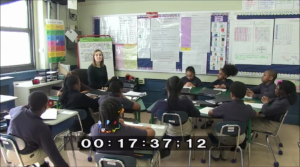04.07.16Watch Carefully: Prevention Beats Cure
 “Students say I’m strict, but I don’t write referrals. How is that?” Peter D. Ford, a teacher I admire, recently tweeted. There’s something deeply important to reflect on in his words.
“Students say I’m strict, but I don’t write referrals. How is that?” Peter D. Ford, a teacher I admire, recently tweeted. There’s something deeply important to reflect on in his words.
In the classroom, as in medicine, prevention always beats cure. What you want is not so much the ability to fix it when students are not engaged in learning (or, heaven forbid, behaving counter-productively) but the ability to keep ‘off-task’ from happening in the first place.
That’s why non-invasive interventions are so important. As this famous clip of Ashley Hinton demonstrates, if you have tiny inconspicuous moves you can use to bring kids back into focus as soon as they start to get distracted, and if you can execute those moves while teaching then the bigger things don’t happen and you don’t have to stop teaching to deal with them- a virtuous cycle.
I was thinking about that when my team and I watched a tiny little clip of Katie Kroell here at TLaC Towers yesterday. It reminds us that there is something even more powerful and subtle than tiny corrections as a preventative tool- it’s the art of looking, and showing students that you look to see what they do… we call it Be Seen Looking.
Watch what happens. Katie and her students are discussing the nature of sacrifice in O. Henry’s short story, ‘The Gift of the Magi’—love that engaging and complex text, by the way. As a student is answering Katie scans the room to make sure everyone is listening and focused. She uses what we call a ‘dance move’ to demonstrate to her students that she is looking- she lifts her chin—as if to see the back—and cranes her neck—as if she was looking around something that obscured her vision.
And here’s what’s so neat about it. The student in the lower left hand corner (we put a light circle around him to make it easier to see) is starting to get a little distracted. While his classmate is talking he’s starting to fish in his backpack for something. And as soon as he sees Katie glance over at him he stops and refocuses on the story. But more than that he decides to stop with no correction from Katie. In other words, this is better than a non-invasive correction because she doesn’t even have to correct. She just looks and in so doing causes him to self-assess whether he needs to be in his backpack then or not.
BC.100.GR4.Kroell.’Sacrifice.’Clip2484 from Uncommon Schools on Vimeo.
That part of course is triply interesting. Is it possible that he getting out something he needed right then? Maybe. Could he have waited til later? Maybe (After all “The Gift of the Magi” is pretty important.) Was he a little bit distracted? Probably. But when Katie looks his way he decides to ignore the backpack for the time being. In other words just by being looked at briefly he decides on his own that his behavior is not the most productive and fixes it.
The class goes on discussing O. Henry, the student stays focused. Prevention is victorious.
So to return to Peter’s question, How is it that strict can mean fewer referrals? It can mean fewer large things going wrong because you have the capacity to fix things when they are small. Or to prevent them from being “something” before they start. And even to have students internalize your expectations—that you shouldn’t really be in your backpack when we are discussing literature because literature is important so you should be fully attentive—so you only have to glance and remind them subtly that you see and care what they do. And if you are caring and clear and firm about your expectations, that can be enough.

Today I had to apologize to a student who was off-task. We were reviewing the ‘game tape’ of a class discussion, and this student was off-task for an extended period of time. I apologized because it was MY FAULT I let it go on as long as it did; the subtle, non-intrusive off-task behavior that ultimately inhibited their learning even though it wasn’t bothering anyone else.
Did the behavior violate class/school expectations? Certainly. It’s the adult in the room’s responsibility to recognize it and encourage better behavior immediately, thus my apology.
No wonder sports coaches study video endlessly; the camera never lies.
So should teachers.